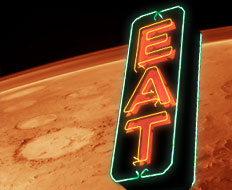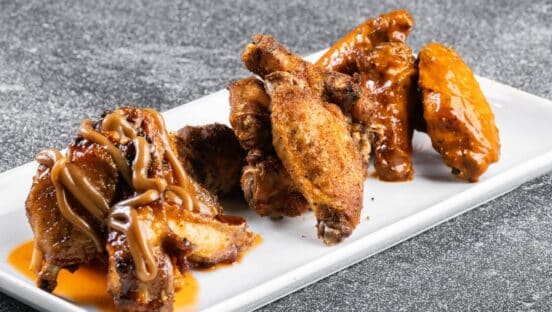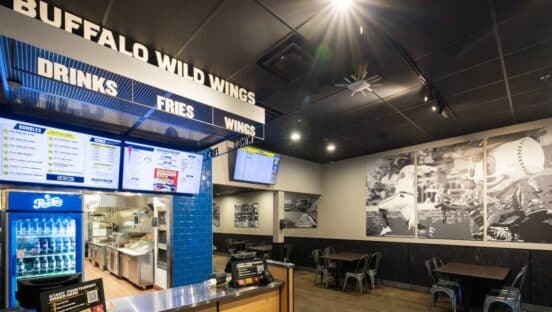Advertising Age recently ran a hilarious peek into the future called “The Most Influential Brands of 2090,” which you can read here. This got us thinking about the future of quick service and what brands in the industry might be dominant 50 years from now. With a nod to Michael Crichton’s novel Timeline for the opening conceit, here is the tongue-in-cheek guess of Greg Sanders, QSR’s associate publisher…
Here in the year 2060, researchers at CalTech have finally developed what physicists have been striving after for decades: the quantum computer. If the predictions about its capabilities are true, it’s not tough to imagine a scenario in which there are no more restaurants.
They tell us the quantum computer is powerful enough to encode the data that makes up a solid object and transport it elsewhere. (If you’re familiar with the long-defunct technology of faxing, it’s much like that.) That solid object could easily be a hamburger or pizza, and where will that leave us? Within a few years, it is entirely possible there will be no restaurants, just a Central Menu Licensing Agency, where consumers can order an entrée from one “supplier,” a side from another, a drink from a third, and a dessert from a fourth, all transmitted instantly to the consumer’s location.
The industry will adapt in some fashion, but it’s impossible to predict the future. And so, as we face the uncertainty of that future, we felt it appropriate to celebrate the eight strongest restaurant brands of today.
The Little Green Man
In the mid-2030s, NASA began launching successful manned flights to Mars. The red planet was found to be habitable by humans, and by 2052 the space agency had constructed several small cities that were populated by people who really did want to get away from it all. These Marsians (who did not care for the spelling “Martian”) were very much into individuality, and not surprisingly, a serious entrepreneurial culture developed.
One of the enterprises that emerged was a restaurant known as the Red Rock Café, which opened its first unit in Alpha Quadrant One and spread rapidly to the other three cities on the planet. Frustrated when there was nowhere else to expand on Mars, the founder exported his concept back to Earth, changing the name to The Little Green Man as a tongue-in-cheek poke at the old-fashioned notion of what space-dwellers might look like.
The concept was an immediate hit and is credited for launching the now-crowded space-casual (or “cosmic-casual,” as some industry wags prefer to call it) segment.
KFC
What foresight did KFC show when, 73 years ago, it became the first quick serve to open a location in China? Or, for that matter, when it opened its first unit in India? Did the brand’s strategic thinkers know just how important those markets would become? Either way, by the time China surpassed the U.S. as the country with the highest gross domestic product, and India surpassed China as the most populous nation in the world, KFC was so deeply entrenched in those countries that it held an insurmountable lead over other competitors, both foreign and native. Today there are as many KFC units in those two countries combined as there are in the U.S.
Pollan’s
In 2010, back when homes were still equipped with kitchens, a popular and well-respected food-reform advocate named Michael Pollan said he hoped people would be cooking at home more in 50 years. I know, I know. The idea that people would be cooking at home at all sounds outlandish today. But you have to understand there was a time when it was, in fact, common for people to do so, although you have to go back more than 100 years to get there. It was already much less common when Pollan made his wish.
Back then he was trying to encourage people to stop eating so-called processed corporate food and return to the habit of cooking with “real” ingredients. The movement fizzled out within a few years, and in 2025 a group of aging food activists essentially adopted an if-you-can’t-beat-them-join-them mentality. They opened a restaurant called The Family Dinner that capitalized on the distant memory of meals served to family members on something called a dining room table. Nostalgia sells, and after rebranding to honor their hero, the founders grew the concept like crazy.
Chick-fil-A
Believe it or not, the dominant mode of personal transportation used to be a land-based vehicle known as the automobile, or car. These devices rolled along on rubber-based wheels controlled by a steering mechanism operated by a driver. Weird, right? The idea of being bound to the ground in daily travels is so quaint.
One thing that hasn’t changed much, though, is the amount of time people spend in their personal transportation devices—and the role quick serves play in delivering food to the PTD. Chick-fil-A has been a master of the move-thru experience for more than 50 years, dating back to the time when the move thru was known as the drive thru. As personal transportation has evolved from those olden vehicles to radar-equipped, accident-free cars and now to today’s hovercraft, Chick-fil-A stays true to its operational focus and successfully maintains its tight control over the move-thru experience.
[pagebreak]
Burger Chef
I bet you didn’t know the über-present Burger Chef chain is a resurrection. That’s right: Burger Chef lived and died before today’s incarnation. A little more than 100 years ago, the first unit of Burger Chef, which the 25th issue of QSR referred to as “one of the biggest might-have-beens in foodservice history,” opened. (Can you believe QSR will soon publish its 800th issue? But we digress.) In just 10 years Burger Chef grew to 900 units, then was snapped up by corporate giant General Foods.
Four years and millions of dollars of losses after the acquisition, General Foods started selling off stores and eventually sold the brand to Hardees, which converted the Burger Chef locations to its own brand. Hardee’s was eventually bought by CKE Restaurants, along with the rights to the Burger Chef name, which CKE more or less sat on. An enterprising Sean Sinelli—great-grandson of legendary foodservice branding genius Jeff Sinelli—made CKE an offer it couldn’t refuse for the Burger Chef rights and has grown the brand back to its former heights.
Newton’s New World Café
Sir Isaac Newton believed the world would end this year. OK, that’s not entirely accurate, as we were all keenly reminded by Newton scholars after the release of the disaster film 2060 last year. What Newton believed is that this year would see the start of a new world, and it was an absolute stroke of genius for the founders of Newton’s New World Café to ride the hype of the movie and the ensuing hype correcting the movie to instant brand success.
Its three locations—in New York, San Francisco, and Orlando—have been open since only the beginning of the year, but AUVs are already the envy of the industry. The concept is riding its vibe, a mixture of edgy hipster and new-age hippie-dippy, to the bank, which is a big part of why I’ll be the first to doubt its staying power. Rapid expansion is apparently in the works, and we all know the risks of relying on style over substance to grow too quickly. But for this year, at least, there is no hotter brand.
Pizza Boss
Nearly 75 years ago, at a time when the Hispanic market in the U.S. was just on the cusp of being large enough to be a specific target for the restaurant industry, a concept called Pizza Patrón opened its doors in Texas, with the idea of serving high-quality, low-cost pizzas to the Hispanic market.
It proved a huge hit, and the chain grew steadily until about 2020. I’ve never quite been sure why it took more than 30 years to do so, or why nobody beat them to it, but finally the company applied its formula to other ethnicities, starting with the Indian market. Pizza Maalik was also a huge hit, and the company, now operating under the umbrella name of Pizza Boss, has launched other concepts, including Pizza Shàng Si for the Chinese market.
McDonald’s
Truth be told, I debated about whether to include this one. Yes, McDonald’s sells a lot of food, and its systemwide sales are far ahead of other quick serves, just as they have been for 100 years. And you can’t think about the long history of fast food without thinking about the Golden Arches—its presence has been and continues to be dominant.
So perhaps this will start an industry debate, but…isn’t McDonald’s more of a convenience store now? Sure, restaurants have been supplying used frying oil to fuel converters for years, but when McDonald’s announced late last year that it had perfected technology to convert used oil into hover-craft fuel on premises, it was a true game-changer. Fuel pumps are in place in about one-third of McDonald’s domestic locations, with the remainder expected to come online by the end of the year. When that happens, McDonald’s will be the country’s largest supplier of fuel for both people and vehicles. I call that a convenience store.





